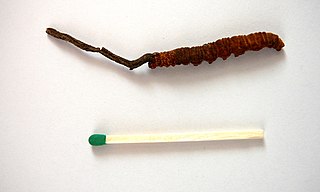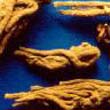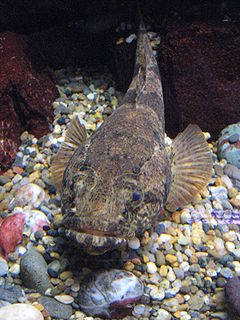
Hibiscus is a genus of flowering plants in the mallow family, Malvaceae. The genus is quite large, comprising several hundred species that are native to warm temperate, subtropical and tropical regions throughout the world. Member species are renowned for their large, showy flowers and those species are commonly known simply as "hibiscus", or less widely known as rose mallow. Other names include hardy hibiscus, rose of sharon, and tropical hibiscus.

Hibiscus rosa-sinensis, known colloquially as Chinese hibiscus, China rose, Hawaiian hibiscus, rose mallow and shoeblackplant, is a species of tropical hibiscus, a flowering plant in the Hibisceae tribe of the family Malvaceae. It is widely cultivated in tropical and subtropical regions, but is not known in the wild, so that its native distribution is uncertain. An origin in some part of tropical Asia is likely. It is widely grown as an ornamental plant in the tropics and subtropics.

Ophiocordyceps sinensis is known in English colloquially as caterpillar fungus, or by its more prominent names yartsa gunbu, or dōng chóng xià cǎo or Yarsha-gumba or Yarcha-gumba, यार्सागुम्बा or Keeda Jadi, or ရှီးပတီး. It is an entomopathogenic fungus in the family Ophiocordycipitaceae. It is mainly found in the meadows above 3,500 meters on Tibetan Plateau in Southwest China and Himalayan regions of Bhutan and Nepal. It parasitizes larvae of ghost moths and produces a fruiting body which used to be valued as a herbal remedy and in traditional Chinese medicine. Caterpillar fungus contains the compound Cordycepin, an adenosine derivative. However, the fruiting bodies harvested in nature usually contain high amounts of arsenic and other heavy metals so they are potentially toxic and sales have been strictly regulated by the CFDA since 2016.

The Chinese mantis is a species of mantis native to Asia and the nearby islands. In 1896 this species was accidentally introduced by a nurseryperson at Mt. Airy near Philadelphia, United States. Tenodera sinensis often is erroneously referred to as Tenodera aridifolia sinensis because it was at first described as a subspecies of Tenodera aridifolia, but Tenodera sinensis is now established as a full species.

Camellia sinensis is a species of evergreen shrubs or small trees in the flowering plant family Theaceae whose leaves and leaf buds are used to produce tea. Common names include "tea plant", "tea shrub", and "tea tree".

Angelica sinensis, commonly known as dong quai or female ginseng, is a herb belonging to the family Apiaceae, indigenous to China. Angelica sinensis grows in cool high altitude mountains in China, Japan, and Korea. The yellowish brown root of the plant is harvested in the fall and is a well-known Chinese medicine which has been used for thousands of years.

Wisteria sinensis, commonly known as the Chinese wisteria, is a species of flowering plant in the pea family, native to China, in the provinces of Guangxi, Guizhou, Hebei, Henan, Hubei, Shaanxi, and Yunnan. Growing 20–30 m (66–98 ft) tall, it is a deciduous vine. It is widely cultivated in temperate regions for its twisting stems and masses of scented flowers in hanging racemes, in spring.

Sinosaurus was a tetanuran theropod dinosaur which lived during the Early Jurassic Period. It was a bipedal carnivore approximately 5.6 metres in length. Fossils of the animal were found at the Lufeng Formation, in the Yunnan Province of China.

Freshwater sleepers are a small family, the Odontobutidae, of gobiiform fishes native to freshwater rivers flowing into the South China Sea and the northwestern Pacific Ocean. The family consists of about 22 species in six genera.

The Asian parti-colored bat is a species of parti-coloured bat. An adult Asian parti-colored bat has a body length of 6–7 cm, a tail of 4.3-4.5 cm, and a wing length of 5 cm. Asian parti-colored bats are distributed across East Asia, from Taiwan through eastern China, eastern Mongolia and Russia (Siberia) to the Korean Peninsula and Japan.

Odontobutis is a genus of freshwater sleepers native to East Asia and Vietnam.
Odontobutis haifengensis is a species of freshwater sleeper endemic to China where it is only found in fresh and brackish waters of Guangdong Province. This species can reach 10.7 cm (4.2 in) in standard length.
Odontobutis hikimius is a species of freshwater sleeper endemic to Japan. This species can reach a length of 15.6 cm (6.1 in) in standard length.
Odontobutis yaluensis is a species of freshwater sleeper endemic to China.
Odontobutis potamophila is a species of freshwater sleeper native to China and Vietnam, is a commercially important fish species used in aquaculture in China. Demonstrating a sexually dimorphic growth pattern where the male grows quicker and larger than the female, this species can reach a length of 11.5 cm (4.5 in) in standard length.

Odontobutis platycephala is a species of freshwater sleeper endemic to South Korea.

Qianzhousaurus is a genus of tyrannosaurid dinosaurs that lived in Asia during the Late Cretaceous period. There is currently only one species named, the type species Qianzhousaurus sinensis which is member of the tribe Alioramini within the group, and most closely related to Alioramus, another alioramin.

Camellia taliensis is a species of evergreen shrub or small tree whose leaves and leaf buds are used to produce tea.













